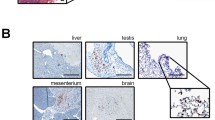Abstract
The recent advances in nanotechnology have a great potential to improve the prevention, diagnosis, and treatment of human diseases. Nanomaterials for medical applications are expected to grasp pharmacokinetics and the toxicity for application to medical treatment on the aspect of safety of the nanomaterials and nanodevices. We describe a generation of CdSe nanoparticles [quantum dots (QDs)] conjugated with monoclonal anti-HER2 antibody (Trastuzumab), for single molecular in vivo imaging of breast cancer cells. We established a high-resolution in vivo 3D microscopic system for a novel imaging method at the molecular level. The cancer cells expressing HER2 protein were visualized by the nanoparticles in vivo at subcellular resolution, suggesting future utilization of the system in medical applications to improve drug-delivery systems to target the primary and metastatic tumors for made-to-order treatment. We also describe sentinel node navigation using fluorescent nanoparticles for breast cancer surgery in experimental model, which have shown the potential to be an alternative to existing tracers in the detection of the sentinel node if we select the appropriate particle size and wavelength. Future innovation in cancer imaging by nanotechnology and novel measurement technology will provide great improvement, not only in the clinical field but also in basic medical science for the development of medicine.




Similar content being viewed by others
References
Torchilin VP, Lukyanov AN, Gao Z, Papahadjopoulos-Sternberg B. Immunomicelles: targeted pharmaceutical carriers for poorly soluble drugs. Proc Natl Acad Sci USA. 2003;100:6039–44.
Krauss WC, Park JW, Kirpotin DB, Hong K, Benz CC. Emerging antibody-based HER2 (ErbB-2/neu) therapeutics. Breast Dis. 2000;11:113–24.
Lyons SK. Advances in imaging mouse tumour models in vivo. J Pathol. 2005;205:194–205.
Ishijima A, Kojima H, Funatsu T, Tokunaga M, Higuchi H, Tanaka H. Simultaneous observation of individual ATPase, mechanical events by a single myosin molecule during interaction with actin. Cell. 1998;92:161–71.
Wu X, Liu H, Liu J, Haley KN, Treadway JA, Larson JP. Immunofluorescent labeling of cancer marker Her2, other cellular targets with semiconductor quantum dots. Nat Biotechnol. 2003;21:41–6.
Gao X, Cui Y, Levenson RM, Chung LW, Nie S. In vivo cancer targeting, imaging with semiconductor quantum dots. Nat Biotechnol. 2004;22:969–76.
Yildiz A, Forkey JN, McKinney SA, Ha T, Goldman YE, Selvin PR. Myosin V walks hand-over-hand: single fluorophore imaging with 1.5-nm localization. Science. 2003;300:2061–5.
Dahan M, Levi S, Luccardini C, Rostaing P, Riveau B, Triller A. Diffusion dynamics of glycine receptors revealed by single-quantum dot tracking. Science. 2003;302:442–5.
Lidke DS, Nagy P, Heintzmann R, Arndt-Jovin DJ, Post JN, Grecco HE, Jares-Erijman EA, Jovin TM. Quantum dot ligands provide new insights into erbB/HER receptor-mediated signal transduction. Nat Biotechnol. 2004;22:198–203.
Krag DN, Weaver DL, Alex JC. Surgical resection and radio-localization of the sentinel node in breast cancer using a gamma probe. Surg Oncol. 1993;2:335–40.
Tafra L, Lannin DR, Swanson MS. Multicenter trial of sentinel node biopsy for breast cancer using both technetium sulfur colloid and isosulfan blue dye. Ann Surg. 2001;233:51–9.
Kurebayashi J, Otsuki T, Tang CK, Kurosumi M, Yamamoto S, Tanaka K, Mochizuki M, Nakamura H, Sonoo H. Isolation and characterization of a new human breast cancer cell line, KPL-4, expressing the Erb B family receptors and interleukin-6. Br J Cancer. 1999;79:707–17.
Leunig M, Yuan F, Menger MD, Boucher Y, Goetz AE, Messmer K, Jain RK. Angiogenesis, microvascular architecture, microhemodynamics, and interstitial fluid pressure during early growth of human adenocarcinoma LS174T in SCID mice. Cancer Res. 1992;52:6553–60.
Braun RD, Abbas A, Bukhari SO, Wilson W III. Hemodynamic parameters in blood vessels in choroidal melanoma xenografts and rat choroid. Invest Ophthalmol Vis Sci. 2002;43:3045–52.
Carraway CA, Carvajal ME, Carraway KL. Association of the Ras to mitogen-activated protein kinase signal transduction pathway with microfilaments. Evidence for a p185 (neu)-containing cell surface signal transduction particle linking the mitogenic pathway to a membrane-microfilament association site. J Biol Chem. 1999;274:25659–67.
Buss F, Arden SD, Lindsay M, Luzio JP, Kendrick-Jones J. Myosin VI isoform localized to clathrin-coated vesicles with a role in clathrin-mediated endocytosis. EMBO J. 2001;20:3676–84.
Kamal A, Goldstein LS. Connecting vesicle transport to the cytoskeleton. Curr Opin Cell Biol. 2000;12:503–8.
Mross K, Niemann B, Massing U, Drevs J, Unger C, Bhamra R, Swenson CE. Pharmacokinetics of liposomal doxorubicin (TLC-D99; Myocet) in patients with solid tumors: an open-label, single-dose study. Cancer Chemother Pharmacol. 2004;54:514–24.
O’Brien ME, Wigler N, Inbar M, Rosso R, Grischke E, Santoro A. Reduced cardiotoxicity and comparable efficacy in a phase III trial of pegylated liposomal doxorubicin HCl (CAELYX/Doxil) versus conventional doxorubicin for first-line treatment of metastatic breast cancer. Ann Oncol. 2004;15:440–9.
Hamaguchi T, Matsumura Y, Nakanishi Y, Muro K, Yamada Y, Shimada Y. Antitumor effect of MCC-465, pegylated liposomal doxorubicin tagged with newly developed monoclonal antibody GAH, in colorectal cancer xenografts. Cancer Sci. 2004;95:608–13.
Park JW, Kirpotin DB, Hong K, Shalaby R, Shao Y, Nielsen UB. Tumor targeting using anti-her2 immunoliposomes. J Control Release. 2001;74:95–113.
Josephson L, Mahmood U, Wunderbaldinger P, Tang Y, Weissleder R. Pan and sentinel lymph node visualization using a near-infrared fluorescent probe. Mol Imaging. 2003;2:18–23.
Patrick W, Karl T, Chrstoph B. Near-infrared fluorescence imaging of lymph nodes using a new enzyme sensing activatable macromolecular optical probe. Eur Radiol. 2003;13:2206–11.
Kobayashi M, Mizumoto T, Shibuya Y, Takeda M, Enomoto M. Fluorescence tomography in turbid media based on acousto-optic modulation imaging. Appl Phys Lett. 2006;89:181102.
Author information
Authors and Affiliations
Corresponding author
Additional information
This article is based on a presentation delivered at the Presidential Symposium 1, “Breast cancer: individualized diagnosis for tailored treatment,” held on 29 June 2007 at the 15th Annual Meeting of the Japanese Breast Cancer Society in Yokohama.
About this article
Cite this article
Takeda, M., Tada, H., Higuchi, H. et al. In vivo single molecular imaging and sentinel node navigation by nanotechnology for molecular targeting drug-delivery systems and tailor-made medicine. Breast Cancer 15, 145–152 (2008). https://doi.org/10.1007/s12282-008-0037-0
Published:
Issue Date:
DOI: https://doi.org/10.1007/s12282-008-0037-0




